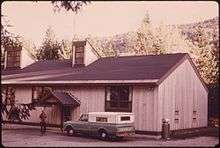Adirondack Park Agency visitor interpretive centers
The Adirondack Park Agency visitor interpretive centers (or VICs) were established in 1989 and 1990, respectively.[1] They were designed to introduce visitors to the special features of the Adirondack Park, which, at 6 million acres (24,000 km²), is the largest park in the lower 48 United States. The centers helped orient visitors to the park via educational programs, exhibits, and interpretive trails. Educational programs were available for school groups as well as the general public. In 2011, New York State sold both visitor centers to nearby colleges. The former Newcomb VIC, now the Adirondack Interpretive Center, is owned and operated by SUNY-ESF. The former Paul Smith's VIC, now Paul Smith's College VIC, is owned and operated by Paul Smith's College.
Paul Smith's College VIC

The Paul Smith's VIC opened in 1989 and in 2011 became the Paul Smith's College VIC, owned and operated by Paul Smith's College. Located on approximately 2,700 acres (11 km2) in Paul Smiths, New York, near Paul Smith's College, the Paul Smith's College Visitor Interpretive Center (Paul Smith's College VIC) has approximately 25 miles of maintained trails. Throughout the property visitors will encounter every habitat type found in the Adirondack Park except alpine. Each spring the PSC VIC hosts the Great Adirondack Birding Festival. Throughout the year visitors can partake of guided interpretive walks, regular outdoor activities, naturalist-led canoe paddles on Barnum Pond, and assorted workshops and programs. In the winter the trails are open for snowshoeing and cross-country skiing. The Paul Smith's College VIC building is open from 9:00 am - 5:00 pm seven days a week mid-June through Labor Day, and open 9:00 am - 5:00 pm Wednesdays through Sundays.[2]
Newcomb center
The Newcomb center, known as the Adirondack Interpretive Center, opened in 1990. Located on 236 acres (0.96 km2) at the outlet of Rich Lake, the center has approximately three and a half miles of interpretive trails. Habitats include lakeshore, wetlands, old growth forest, and mixed northern forest. Throughout the year staff conduct naturalist-led trail walks, guided paddles on Rich Lake, and assorted workshops and lectures. All trails are open in the winter for snowshoeing; cross-country skiing is permitted, and requires varying degrees of skill depending on trails and conditions. Dogs are allowed on leash year round, and owners are asked to please clean up after their dogs to preserve trail conditions for all users. The Adirondack Interpretive Center is open from 10:00am to 4:00pm, Tuesday through Saturday. It may occasionally be closed; calling first is advised.[3]
Relinquishment of sites by New York State

Due to state fiscal and budgetary constraints, Governor David Paterson marked the VICs for closure on December 31, 2010.[4]
Management and ownership of the Newcomb center was assumed by the SUNY College of Environmental Science and Forestry (SUNY-ESF) on July 1, 2010, with program responsibility beginning January 1, 2011.[5] The Adirondack Interpretive Center is situated on ESF's Huntington Wildlife Forest, a 15,000-acre (61 km2) biological field station the college has operated in Newcomb since 1932,[6] and also home to the College's Adirondack Ecological Center.[7]
Management and ownership of the Paul Smith's Center was assumed by Paul Smith's College in January 2011.
Notes
- How the VICs came to be - AdirondackDailyEnterprise.com | News, Sports, Jobs, Saranac Lake region — Adirondack Daily Enterprise
- "Paul Smith's College VIC Hours," Paul Smith's College VIC website. Accessed: September 17, 2016.
- "The Center for Nature Interpretation in the Adirondacks," Adirondack Interpretive Center website. Accessed: March 12, 2014.
- NCPR News - Both Adirondack Interpretive Centers to go Archived July 23, 2011, at the Wayback Machine
- ESF Takes Over Adirondack Visitor Center
- SUNY-ESF: Adirondack Ecological Center
- SUNY-ESF: Adirondack Ecological Center
External links
- Adirondack Interpretive Center (Newcomb, NY)
- Paul Smith's College VIC (Paul Smiths, NY)